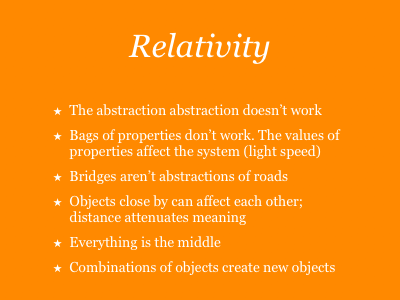
Here’s the problem: the world isn’t an abstracted world of objects. We can’t just swap one object out and replace it with another. It works for planets, sure, but it doesn’t work for anything else.
Like, what’s the effect with roads and trucks and gravity? It’s fine, step-2-gravity works really well. What about when we abstract the road and replace it with a bridge? Well, the abstraction holds up really well for a while, then the bridge breaks because the truck is too heavy and we realise that objects aren’t interchangable.
Or when things go really fast: they get more massive. The equations break down.
There are two twists we have to make to the Newtonian model:
- There isn’t just one single space that everything sits in. There are little spaces that only make sense if you stand on the inside. Everything is a middle. All the spaces can work slightly differently. These are relativistic reference frames. From each one, they look like the central one. But really none of them is. What we’ve introduced is locality to the space. If things are close by, they work in the same way. The objects close to each other can relate to each other, but objects further away can’t at all. To talk about “distance” between two objects in different spaces doesn’t make sense, if you think it’s the same kind of distance between two local objects.
- An object isn’t just a bag of properties that is interchangable for another bag of properties. The bags of properties are as complex and go as deep as the reality of the objects themselves. Everything about the objects is important. And here, there are more properties too: Two objects that are affecting each other create new possibilities between themselves that didn’t exist before. The two of them create a new object. There’s a person and a hammer: The two of them together create the object which is “hammering” based on an infinite number of things: The shape of the environment, the hardness of average objects, the length of the arm, the shape of the hammer, and so on. When the person can perceive this possibility in the hammer, we call it an affordance, but really it’s all of these things, bound up.
In physics, this is relativity. [In society too, where we resist it, which indicates that a simple form of relativity isn’t any good at all. There are many kinds of space, many kinds of locality. We should derive “distance” from “meaning,” rather than the other way round, but then we’re stuck with defining what “meaning” is. I’d say, if things move together they go together. Deduce distance from behaviour.]
Matt Webb, posted 2005-09-02 (talk on 2005-06-11)